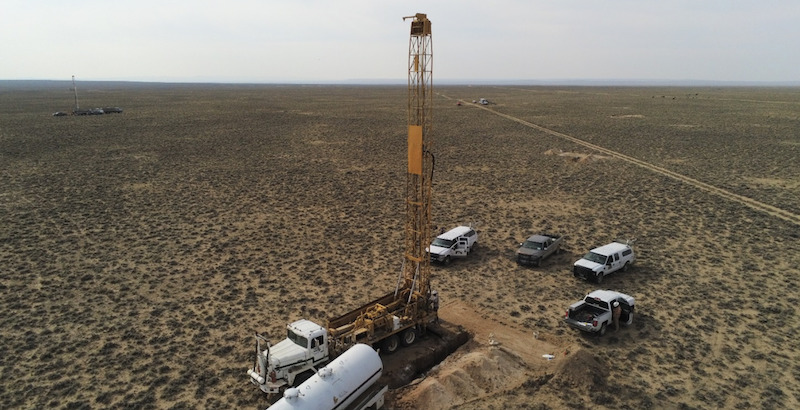Nuclear appetite takes hold as US looks to secure its energy future
Mining
Mining
The wheels are well and truly in motion on US uranium, according to Bruce Lane – and the nation could be about to put the foot down.
For the executive director of Wyoming-focused ISR uranium play GTI Energy (ASX:GTR), a recent trip to US nuclear renaissance heartland has solidified the rising confidence seen in social media feeds and news editorials in Australia for a while now.
The US uranium revival is on.
“There’s a level of public acceptance over there now that nuclear is part of the future, it’s something I haven’t seen on that level before,” Lane told Stockhead.
“The US Department of Energy has made some massive statements which are beneficial to pretty much everything to do with the nuclear business and supply chain, including their recently announced program for small-scale reactors (SMR’s) that must get uranium from newly mined domestic sources.
“SMR’s seem to have a bit of green energy sexiness to offer, especially with Warren Buffett and Bill Gates behind it, it’s got new technology and innovation appeal.
“There’s a real hunger for SMR’s from the likes of Wyoming, Utah and Idaho – a number of states are witnessing uranium’s revival and really keen to get on that bandwagon and get things going.”
That should come as no surprise. In April, the Biden administration unveiled its Civil Nuclear Credit Program – a US$6 billion initiative designed to support the continued operation of US nuclear reactors.
At the time, US Secretary of Energy (DOE) Jennifer Granholm made abundantly clear that the nation would prioritise nuclear as a clean form of power.
“US nuclear power plants contribute more than half of our carbon-free electricity, and President Biden is committed to keeping these plants active to reach our clean energy goals,” she said.
“We are using every tool available to get this country powered by clean energy by 2035, and that includes prioritising our existing nuclear fleet to allow for continued emissions-free electricity generation for economic stability for the communities leading this important work.”
It’s not just existing plants – a recent DOE study identified more than 250 gigawatts of operating and retired coal power plants which could be converted to nuclear, using new-tech small modular reactors (SMRs).
Separate from this, August’s Inflation Reduction Act authorised DOE to lend up to US$250 billion to projects bringing old energy infrastructure, like coal power plants, back to life.
Reuters recently reported that only one company currently sold the sort of fuel required for the new gen SMRs, known as HALEU – a Russian firm at a time of geopolitical and trade instability between the two nations.
There’s probably no need to elaborate on the dynamics of that relationship at present. A DOE spokesperson told the news agency that the nation considered this a matter of priority.
“We understand the need for urgent action to incentivise the establishment of a sustainable, market-driven supply of HALEU,” they were reported as saying.
Meanwhile, Chinese President Xi Jinping made his first trip out of the motherland since the beginning of the COVID-19 pandemic in January 2020.
Where in the world did he go? Kazakhstan, of course. The world’s largest uranium producer.
Much of those exports go to China, which is investing very heavily in nuclear as part of its own low emissions energy push.
It’s little wonder the sentiment has changed on the ground in the US, with domestic explorers and developers in the box seat to capitalise.
“We’re not quite sure when the growing demand equation will flow through to the price,” Lane said.
“But the fact of the matter is if everybody who was buying uranium over the last six months gets in and buys there simply won’t be enough material.
“The more plants restart, the more people buy, the higher the price will have to go.”
Few US uranium regions have the green credentials of Wyoming’s Great Divide Basin, where GTI Energy (ASX:GTR) is currently drilling in the Red Desert at its Thor ISR uranium project.
The company recently uncovered significant new uranium trends at Thor. The results of the first 40 holes of drilling were said to be better than expected and demonstrate the potential of the area for an economic ISR development.

ISR stands for in-situ recovery – regarded the lowest cost, lowest impact form of uranium mining. It has been practiced in Wyoming since the mid-1980s, and if GTR’s fellow basin operators are any indicator it’s quite the business to be in.
These include household uranium names like Ur-Energy, Rio Tinto, Energy Fuels and UEC.
GTI’s drilling is part of a 100,000ft campaign, with 70 holes planned in total.
It’s a nice place to be as the US looks for new fuel sources with nuclear front and centre.
This article was developed in collaboration with GTI Energy (ASX:GTR), a Stockhead advertiser at the time of publishing.
This article does not constitute financial product advice. You should consider obtaining independent advice before making any financial decisions.